13 Trees You Should Never Plant In Your Yard
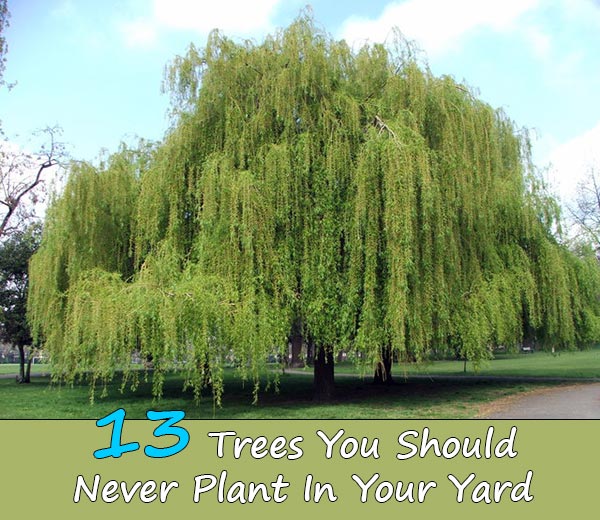
For most people, the end of summer and approach of autumn means cooler temperatures, harvest time for crops, and of course, the vibrant colors of changing leaves. For those looking to grow trees or shrubs, however, the approaching fall means it is almost the perfect time to plant for next season. Cooler air with warm earth gives trees and shrubs a chance to establish good root growth before having to face the heat of another summer.
As you prepare to plant, be mindful that while some tree varieties grow quickly or provide a lot of shade, they can come with some less-than-desirable and unexpected consequences. Following is a list of trees you should avoid incorporating into your landscape this fall:
Ash
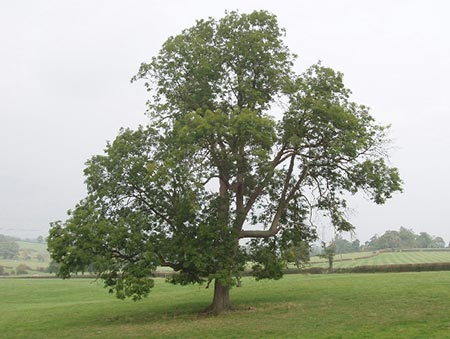
Ash trees are very prevalent around major metropolitan areas. Commonly used to beautify sidewalks and park settings, these beautiful and strong trees are also the source of professional baseball bats. As rock-hard as ash wood can be, however, this tree is widely being wiped out by a tiny beetle called the emerald ash borer. If you want a tree that will be a long-term resident of your landscape, your money would be better spent on another variety!
Black Walnut
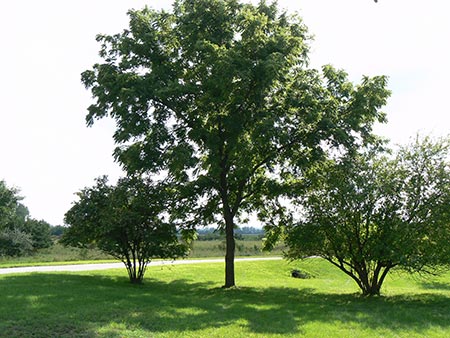 One of America’s most valuable and beautiful native trees, black walnuts are so sought after for their use in furniture and cabinet making that they actually inspire theft in some areas! For home planting, however, black walnut trees produce a lot of pollen and hard flesh-covered seeds that may just drive you nuts when they litter your yard in the fall. Worse yet, however, are the toxins secreted by this tree that can pretty much wipe out nearby flower beds and vegetable gardens.
One of America’s most valuable and beautiful native trees, black walnuts are so sought after for their use in furniture and cabinet making that they actually inspire theft in some areas! For home planting, however, black walnut trees produce a lot of pollen and hard flesh-covered seeds that may just drive you nuts when they litter your yard in the fall. Worse yet, however, are the toxins secreted by this tree that can pretty much wipe out nearby flower beds and vegetable gardens.
Bradford Pear
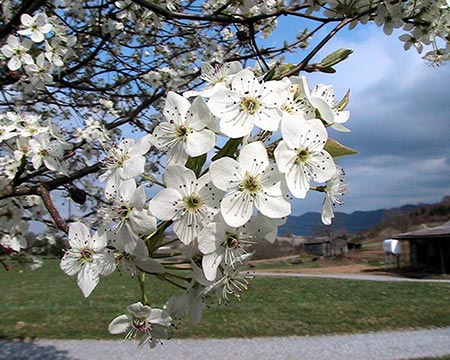
The Bradford pear tree became a favorite of developers due to its ability to create instant shade and grow quickly. The tree produces beautiful white flowers in the spring, but has more than its share of issues. Among them, the fact that the fast growth of the tree leads to weak wood that can be a hazard during storms or windy conditions. Furthermore, the beautiful blossoms are actually quite high on the stench scale. In many areas the Bradford pear is also earning a reputation as an invasive weed.
Eucalyptus
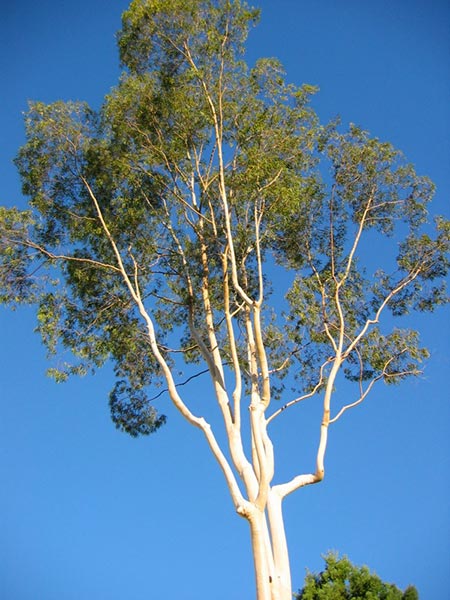
Native to Australia, eucalyptus trees were imported and favored in America for their rapid rate of growth. In fact some varieties can grow up to ten feet in a single year. Unfortunately, eucalyptus can be a bit of a maintenance nightmare due to its seasonal shedding of its bark. Large sticky branches are also known to suddenly drop off and come crashing to the ground (or whatever else happens to be below them).
Gingko
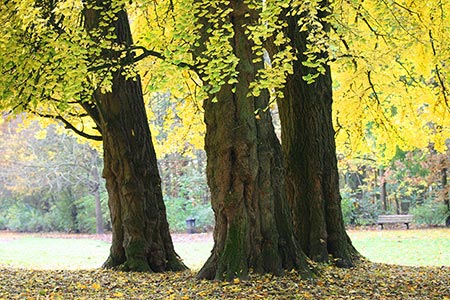
Ancient and beautiful, gingko trees are hardy in various climates and radiate beautiful yellow colors from their fan-like leaves in the fall. Unfortunately, the female variety of a gingko biloba produces some of the messiest and smelliest fruits of any tree. Often referred to as a “trash tree”, the smell of the distinctive fruits dumped by a female gingko is often compared to that of vomit.
Leyland Cypress
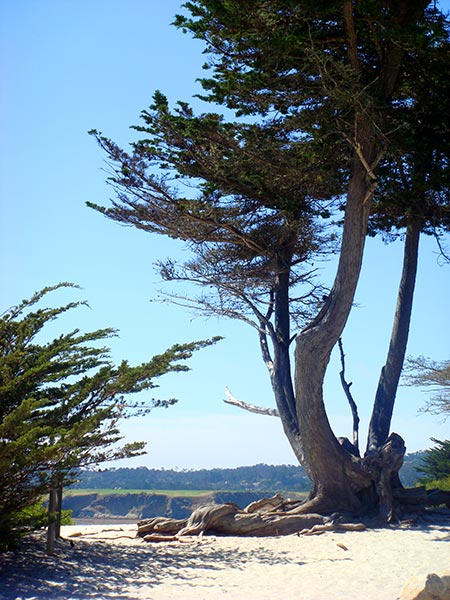
Touted as “America’s most-planted privacy tree”, Leyland cypress trees grow very quickly, up to 5 feet vertically per year. They also thicken well to essentially create a living privacy fence. Unfortunately, they require a great deal of trimming and maintenance to keep them healthy. As they get taller, they become increasingly likely to uproot during storms or windy conditions, but that is not the worst of their characteristics… The center of the tree can become a dry, twiggy fire hazard, so much so that they are now advised against in many areas.
Linden, a.k.a. Basswood
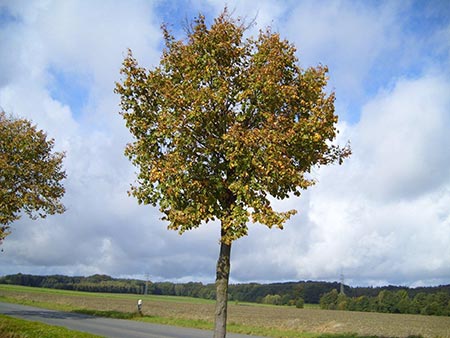
Lindens are slow-growing and grand deciduous trees that can reach up to 130 feet in height. Linden trees grow beautiful and pleasantly fragrant flowers in the summer, which unfortunately are like a magnet for bees. Many people who live around lindens also take exception to the fact that for about a month, these flowers drip a sweet sap which doesn’t discriminate about where it falls, be it on cars, driveways, etc.
Lombardy Poplar
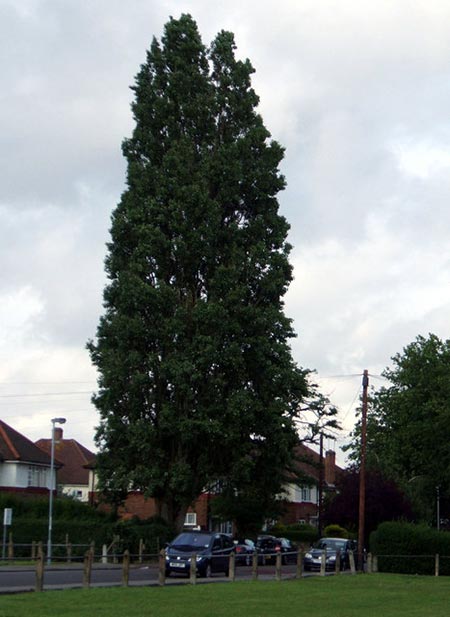 Another fast-growing privacy tree, Lombardy poplars grow up to 6 feet per year and can make excellent windbreaks. Well, at least for a short time… these trees are susceptible to a number of pests and diseases that can turn them from a beautiful border to an eyesore in short order. The running roots of these trees are also very invasive to surrounding plants and difficult to get rid of.
Another fast-growing privacy tree, Lombardy poplars grow up to 6 feet per year and can make excellent windbreaks. Well, at least for a short time… these trees are susceptible to a number of pests and diseases that can turn them from a beautiful border to an eyesore in short order. The running roots of these trees are also very invasive to surrounding plants and difficult to get rid of.
Mimosa
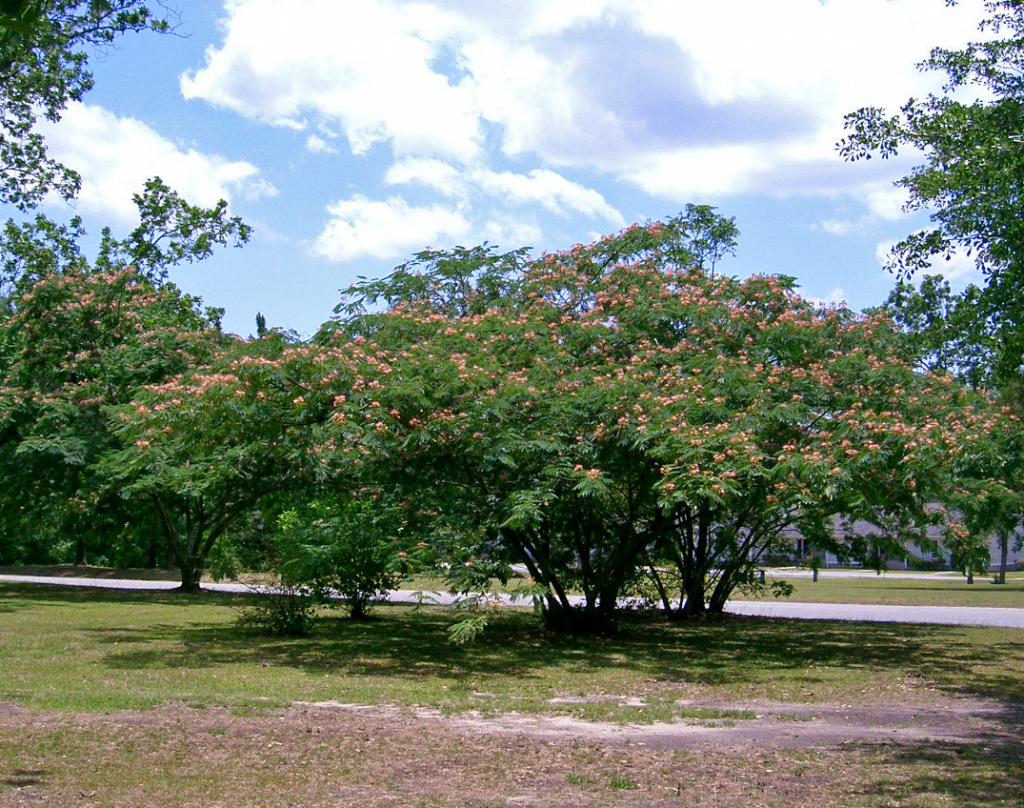
Also known as a silk tree, mimosas are known for their beauty, with frilly leaves and puffy pink flowers. Despite their beauty, however, mimosas are weak-wooded and produce high numbers of extremely invasive seedlings. Mimosas also dump their pretty flowers and leaves as far as they can, making them less than popular among nearby neighbors.
Mulberry
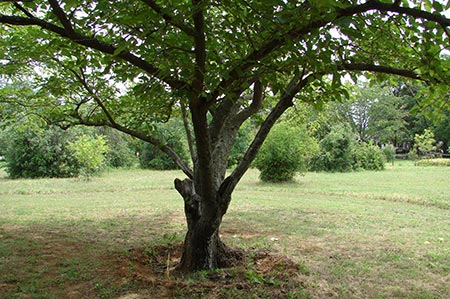
Mulberry trees are amazing shade trees. In fact, they can shade areas so efficiently that grass and other plants underneath them have about no chance of survival! Furthermore, the fruits of a mulberry tree can get quite messy and lead to highly invasive seeding. Mulberry trees also tend to develop a lot of large and extremely shallow roots.
Quaking Aspen
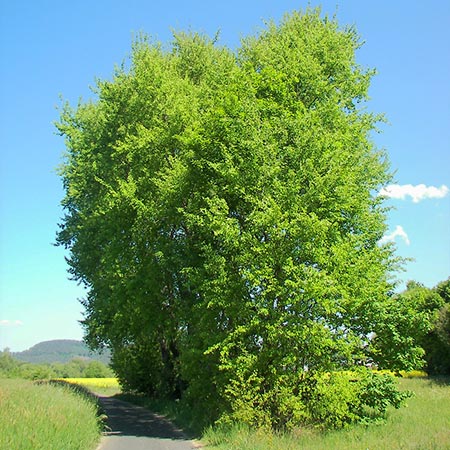
If you were to ask a horticulturist whether you should plant a quaking aspen in your landscape, you’d likely get a response of “Well, you could… but…” These trees are beautiful, grow quickly, and have gently vibrating leaves which turn a beautiful bright yellow in the fall. The downsides of these trees is that they tend to have shallow roots that shoot up obnoxious sprouts. While the root system of quaking aspens can be invasive and near impossible to keep underground or eradicate once established, the trees themselves are not likely to last terribly long. Quaking aspens are prone to disease and can be rather short-lived compared to other hardwoods.
Silver Maple
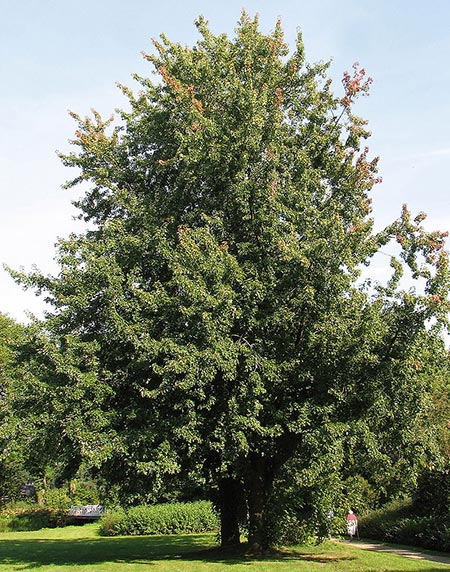
Another variety of hardwoods that can be problematic is the silver maple. While large, fast-growing, and a great shade producer, silver maples can have weak wood that can create issues during storms and wind. The shallow root system of silver maples and their tendency to seek out moist environments also makes them a nightmare for sewage systems and drainage pipes. The roots are also notorious for cracking up nearby driveways and sidewalks.
Willow
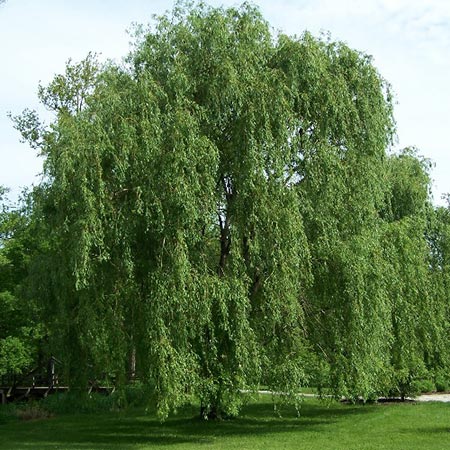 While beautiful on the outside, willow trees are also extremely water-hungry and can absolutely destroy drain fields, sewer lines, and irrigation systems in a home landscape. The lifespan of a weeping willow is also rather short, only lasting about 30 years. Further, the wood can be weak and very prone to cracking upon maturation. While not a particularly valuable landscape addition, certain varieties of willows are essential for the natural preservation and restoration of stream and river banks.
While beautiful on the outside, willow trees are also extremely water-hungry and can absolutely destroy drain fields, sewer lines, and irrigation systems in a home landscape. The lifespan of a weeping willow is also rather short, only lasting about 30 years. Further, the wood can be weak and very prone to cracking upon maturation. While not a particularly valuable landscape addition, certain varieties of willows are essential for the natural preservation and restoration of stream and river banks.
 Home and Gardening Ideas At home and Gardening ideas we believe inspiring readers about homesteading, self sufficiency
Home and Gardening Ideas At home and Gardening ideas we believe inspiring readers about homesteading, self sufficiency




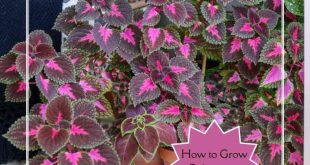

Your style is really unique compared to other folks I have read stuff from. Thank you for posting when you have the opportunity, Guess I’ll just bookmark this site.
Magnificent goods from you, man. I’ve understand your stuff previous to and you’re just extremely magnificent.
I really like what you’ve acquired here, really like what you are
stating and the way in which you say it. You make it entertaining and
you still take care of to keep it wise. I can’t wait to read far more from you.
This is really a great website.
Very good and accurate information for the layperson. I work at a tree farm/nursery and would like to add a couple of trees to your list. Sweet gum trees are especially beautiful for fall foliage but their seed cases are extremely uncomfortable near a residence. Sycamore trees are large beautiful trees with masses of shade but very messy – exfoliating bark, large thick leaves and seed pods that re-seed at a prolific rate. We grow and sell these, and most of those on your list but make sure the customer is aware and can place the tree properly.
I live next door to several elm trees. They are a nightmare. I pull up HUNDREDS of seedling trees every year.
I planted Siberian Elm around the fenceline, now I wish I hadn’t! Their root system is phenomenal, we just had to replace a section of the sewer line as it was full of these roots!
I would like to add another couple of tree species to this list. The first is Russian Olive. Lots of small leaves and bark that sheds. The second is the Cottonwood tree. The cotton clogs air conditioners and can cover the ground with “snow” also can be troublesome with constantly losing branches.
i would love to add them to my page would you mind doing a small write up like mine and i will add this with your name as credit if you like?
Never, ever purposely plant a sweet gum tree in your yard unless you enjoy stepping on large balls of pointy prickly seeds that must be raked up before you cut your lawn. Or you can take your chances but make sure you are efficient at putting your belt back on. And keep extra blades on hand too, as these balls will wear away your blades. They also have weak limbs that fall during storms. I hate the one that is in my front yard. One of these days I will save enough money to get it cut down.
Good info on what trees NOT to plant (I just cut down a Bradford Pear that the builder put in the front yard), but the obvious question that comes from this article is: so what trees SHOULD we plant?
very true 🙂 i will look into that 🙂
I like the idea of my landscape working for me, in addition to aesthetically pleasing. I like native trees and bushes for a multitude of reasons such as hardiness. Bear in mind it’s never good to plant near a foundation, although it seems to be a common practice. Also, fruit bearing trees and bushes will attract wildlife (deer, birds, rodents). Squirrels will only nest in hardwoods. Most states have an invasive species list; consult the DNR website and avoid those.
In my area, I like thorny hawthorns to provide shelter to songbirds but it’s probably not the best selection around kids and dogs unless you plan on teaching them what no means. With the internet, it’s now fairly easy to find out what is native. It’s more difficult to find nurseries that stock natives.
Any oak variety, cypress, non-silver maples, sycamore (lots of leaves and seeds), pine and cedars. All trees have their disadvantages, many are victim to diseases and pests. The key is picking ones that work with your landscape, your yard size and proximity to your home. Small yard = avoid big tress. Don’t like maintenance = don’t plant fruit trees. No matter the tree, the time will come to help with with an issue of some sort.
Check with your local Extension office & the Master Gardeners will be happy to help you !
Is this list intended to be region specific? I would have added (at No.1) Crepe Myrtle. In the gulf coast region if you let just 1 in you will pay for it; and lord help you if you buy a house that let them go (like us). I have cut, poisoned, burned, pulled, and dug up to have to do it again the next year. It is worse than kudzu!!
Add Chinese Tallow to that list. It is invasive in the southern coastal areas to the point of kudzu. It has weak wood and huge amounts of seeds that must all sprout. It is filling the forests and choking out native trees. The seed pods are sharp and are hazardous to bare feet.
The catalpa tree has beautiful huge fan likeleaf and orchid like flowers. Those also ooze sap for the duration of the flowering and the leaf are always sticky. Eventually they grow very long seed pods which remain on the tree until they split and the wind carries the pods and seeds for hundreds of feet, seedlings are quick to grow and quickly develop a deep tap root that is difficult to remove.
Great information, thank you. I own acreage and had a very low wet area that took most of the summer to dry up, making mowing a pain in the butt. I bought a weeping willow several years ago, and once it got established, it has done a remarkable job of keeping this low area dry. They do have their good points and good uses, as long as one is mindful not to plant them close to drain fields, water or sewer lines etc. Mine is also not close to the house or garage so falling branches, should there be any, would not cause a problem.
Another to tree to add is ‘BAMBOO’… Its hard to kill and eradicate once you plant it. The roots system grows deep. Roundup only browns the leaves for a short time, then grows thicker as it seeds.
Bamboo is a grass.
I planted bamboo about 18 years age not knowing anything other than I wanted to hide the building behind me. Btw I live in Buffalo NY… have a very small yard in the historic area of the city known as Allentown…. well I released a monster…my neighbor hates me in the spring when it grows over three feet a day. I now snap that off @ the base & it does help. Btw it did grow to 25 feet or so( so my goal was reached)… and three winters age it was so cold that it actually died back @. Had to start again. I responded by planting rose of sharon( a bush menace but so lovely in July & aug that I still find it irritable) mallow& bulletfly bush toward the front. I do believe I can have some control if I keep after the sprout bunches. Our daughter lives in Philly & thrrr was also a. Am ok for back there that year. Who knows what next years mondter crop will bring…. there doesn’t seem to be any way to kill it so I’m just muddling along. It certainly is dramatic I’ll give it that…. didn’t know about clumping bamboo back then…. the other thing is it keeps its leaves all winter so I never have to look @ the hotel again. @ btw…. it poked up through the tar in the alley behind our house
What about Chinese Elm trees? Do you know anything about those?
What most places call “Chinese” Elm are really Siberian Elm. Fast growing and EXTREMELY invasive.
Australian Pines they are very invasive and cause a lot of underground problems including starting new trees all along the the root trail… JUST HAD A LOT OF THEM REMOVED..they were on public property but were invading my underground utilities…the City removed them and we found out the are not approved in sum Florida counties. https://images.sciencedaily.com/2008/10/081031213814_1_900x600.jpg
black walnut is an excellent prepping tree since the nuts can be stored for long periods of time. The green husk of the nut can be put in a pillow case or sack, smashed throughly, dip well in a body of water and knock fish out for easy catching. The bark of the willow tree can be chewed for its aspirin ingredients. The Bradford pear tree is great for hubby bees. Nice site for a city dwelling home owner but horrible for preppers
That’s honey bees. Sweet gums, however bad the balls are, is an excellent food source for birds. Catapala trees are great for the catapuller that eats the leaves. The catapuller is an excellent fishing worm. Bamboo is a fast growing plant and is being used for pulp in some regions taking the place of pine trees
I agree with John, some of these trees might be a problem but that goes with thinking what one considers a problem..I would plant Linden trees out in my land to help BEES, they need all the help they can get. Maybe i think different because i am not a city dweller.. Willow is great for using the wood for baskets/fencing too. im not really understanding this list, it seem its mostly about sap and mess on the ground, WHO CARES!!!…Dont park under the tree
Linden trees r used as street trees in Buffalo NY…. if your car is ever parked under one u will know why they r a bad choice….otherwise beautiful tesr shaped but need lots of space to be lovely. Also brittle. Had a 30 yr old one in fr of our house…. I loved looking @ it’s branches through the bedroom window as the snow was falling…. hooked by a garbage truck. Then got Katsura japonica…. now that ones about 17 yrs old. Beautiful tree…. leaves r beautiful colors spring& fall… females have small seed pods… only drawback…. trucks take out branches constantly… in always out there yelling & some idiot who gets in too close to them w a delivery truck.
I wanted to say that Lindens are good prepping trees. You can use linden blooms to make tea that helps against coughing (pick fresh blooms, dry and use in winter). This tea will also help to lower fewer.
Also bark of young linden tree shoots were used as a rope because they bend nicely and are strong.
Yes u can… a German neighbor taught me when to take blossoms to make tes
I would have to disagree with some of those choices. I plant black walnuts (nuts/dye/wood) along with hackberry (fruit/wood) trees and mulberries (fruit and great coppicing tree for firewood) around those. This combo is excellent as the hackberry negates the juglone to a certain extent and allows other things to grow around them. All of these are food producing trees and that is very valuable to me. I would also love to have several female ginko trees that were old enough to bear fruit. The nuts, once cleaned are absolutely delicious and very high in protein. I also love the lindens because they are a multipurpose tree and that is what I am looking for. Willow makes pain reliever (bark) and the growing tips can be steeped to make a natural rooting hormone so I get to make even more trees and shrubs. I suppose permaculture preppers look for different things in their trees than most.
Please consider adding the Bean Tree. This tree is absolutely horrid. My neighbor has one and all winter and spring when the wind blows, I get those horrid bean pods about 12″ long and I get hundreds upon hundreds of these in my yard. My neighbors feel the same way but I am the most that the most of the pods. The bean seeds root fast if I don’t get them quickly and there will be a ton of bean trees. I even get them in my dog yard which has a 6 foot fence.
I believe the tree you’re referring to would be a Basswood. They do have the long “beans” on them.
A “bean tree” is probably either a mimosa or catalpa tree.
always i used to read smaller posts which also clear their motive, and that is also happening with this paragraph which I am reading at this
place.
Add Siberian elm and tree of heaven (ailanthus). We live in a river valley and these spread like weeds. The ailanthus are almost impossible to eradicate. The elms get slime flux and elm leaf beetles, so are generally nasty, weepy trees. They both are heavy consumers of water as well.
I don’t think anyone actually plants tree of heaven. Tree of Heaven just show up in your yard and try to make it into a forest. They do where I live at least.
Nice trees for the desert SW include London Plane tree, other sycamores, oaks (cork oak or emory oak especially here in the arid SW), pecan and other fruit trees. If you are at high enough altitude, pinyon pine is a winner.
I plan on getting a linden tree next year love the smell, and I’m a bee keeper.
No mention of one of the worst tree for my area. The dreaded China-berry. The whole tree is toxic especially the fruit. Fast growing weak wood is constantly breaking. The seed sprout everywhere and become an invasion mess. You mentioned ash trees as a bad choice. But not all Ash trees are the same The native ash tree of my area Texas Ash (also called Mexican Ash) is a slow growing variety. Not like the Arizona ash. I also noticed the Chinese Tallow and Cottonwood didn’t make the list.
Chinaberry Tree (Melia Azedarach) WORST TREE EVER! True definition of a weed tree! I’ve had many of the ones in the list and NONE were near as bad as this one! The ONLY thing that’s good about them is they give shade and ANY tree will do that! Extremely messy-always dropping something: leaves, stems, flowers, or huge amounts (thousands) of drupes (aka marble sized toxic-to-humans berries). They get about 30 to 50 foot tall and have weak limbs that break easily (I mean just the weight of the drupes will break large branches!) contributing to the mess. They say the tiny, can’t see, flowers smell good-their litter gets everywhere, but nope never smelled them, but the leaves smell extremely noxious. The berries get everywhere and will sprout baby trees all over-flowerbeds, gutters, cracks, anywhere. Shallow root systems clog drains & septic system. Previous owners thought a few would be great-right next to the house, patio, driveway and septic. I’ve had huge branches fall on my roof, tear off my gutters, and smash my plants below. It’s costing me $500 to get rid of them! STAY AWAY!
Maples are another tree to watch out for. They love to have their roots at the surface. Trip hazards and a nightmare to using a lawnmower over. Magnolias…leaves are hard to get rid of. Seed pods are a pain in the a$$. All trees have their good points and bad points. Just know what you are getting before planting.
My willow saved our property! We had uneven landscape that filled with water then drained down into our back yard creating ridges and fence destruction. We planted a willow and we have had no yard flooding since. It also provides play space for the children and great shade for swings.
Sometimes there are needs got these trees. I love my willow!
It’s good for people to be aware of what they are committing to when they plant a tree, however some of these trees can be good choices for particular circumstances. If you have a stream bank, for example, a willow can help hold it together and protect it from erosion from spring flooding. Silver maples and Lombardy (and other) poplars grow fast and provide quick shade and beauty, as long as you plant hard maple or other long-lasting trees to take their place as they age out in 15-20 years. As for trees that litter, nothing dumps more leaves than a good healthy rock maple tree! There are no “perfect” trees out there, just choices from benefits vs. drawbacks. Some have more than others (and yes, I have seen black walnuts literally cripple and kill other trees!).
Another tree that is a real mess is a locust tree. And never plant mesquite trees in your yard, they have a weak root system, I guess, because they are easily uprooted. I do love mimosas though and will put up with the mess. Sycamores grow fast but only live about 25 years and are pretty messy with their peeling bark. They do turn a beautiful yellow in the Fall though.
Ok, I read page one of two. I cant seem to find the button or arrow to continue reading the 13 trees you should avoid. Kibda getting sick of the hidden link butoons abd click on nothibg but advertiser links. Turned me off from reading any further honeandgarden.com articles.
i feel like we are missing a big one here! chinese sumac! “tree of heaven” “tree of paradise”–more like tree from HELL! my front and back yard were so overwhelmed by this evil tree that we had to spend $900 to get it all removed! As soon as you sever this tree’s stem/trunk, it immediately redirects its nutrients to TONS of tiny offshoots and saplings connected to one root system. Incredibly invasive and difficult to eradicate, it killed my roses and threatened my grass and vegetable garden! Yet people still use this tree really commonly in landscaping; I see it EVERYWHERE.
It’s all over my back acre or so. Been cutting and burning for heat after seasoning for several months. Not great as far as firewood goes, but it burns and it’s free.
You should have included Box Elder trees, a form of soft maple. They are super messy, create tons of those helicopter seedlings that find their way into everything, gutters, car air intakes, a/c ducts ect ect. And the trees tend to be very brittle, shedding branches all the time, have high rates of die off in the limb structures and also tend to attract all kinds of bugs and ants due to the dead wood the tree always seems to have. I have a number of them on my property and I really dislike them but the cost of taking them out is just too high for my budget right now.
Yup, box elders are HORRIBLE. A former owner of my house planted box elders in the back yard, presumably because they grow fast and provide a lot of shade. Unfortunately, they also sprout new box elders all over the lawn from those helicopter seedlings, and they grow like weeds. it is a never ending battle to pull them up before they get too tall. They are prone to bugs and have weak wood, so as they get tall, they become prone to toppling over in a storm. About 2 years ago, we had one very large box elder drop a branch across the entire back yard and the neighbor’s yard, damaging a part of their back deck. I couldn’t afford to have the tree removed, and this year it split in half and fell between our houses. The tree was about 80′ tall and fortunately missed the neighbor’s kitchen and my bedroom. Another slightly smaller one fell during a storm and crushed part of my fence. We have cut down box elders leaving only a small stump, and they grow back. A few have even grown into/through my chain link fence. Box elders can be beautiful shade trees, but they spread and grow like weeds and can do a lot of damage when they fall. I would not plant one in an urban environment. I still have a few older, large (50′ tall+) box elders in my small back yard, but I can’t afford to hire a tree service and they would be dangerous for an amateur to cut down–too close to houses and garages, etc.
Some years ago I lived on a hill in an open are and my bradford pear tree froze in March after a cold spell. In the deep south it froze. Another tree that may not be good to plant is river birch, the roots spresd and become invasive no matter what is in the way-concret porch, sidewalk.
Every tree has a purpose. The homeowner just needs to do him homework as to what would work for his yard. There is a now a variety of Bradford pear that is a much better choice. Gingo- a proof positive male tree is available. New variety of sweet gum has no seed pods or balls. We not only have a sweet gum, but also a Gingo and a sawtooth oak.which has the biggest acorns I have ever seen. But, the wild turkeys I. The woods come down to feast on my acorns. Trees are a lifetime decision and research is a must!!!!!
I’m sorry…hahaha…I’m laughing at a lot of these comments. This is NATURE; nature does what it is supposed to do. Every tree in it’s own way, as much as we hate ” their way ” is doing what Mama Nature has taught/hoped for it to do. Mother Nature, if all goes well, is an absolute pain in the ass. Miss Nature wants/hopes/needs for her very naughty, wild, prolific,defiant, abhorrent children to exist. Don’t hate her because she’s beautiful; love her because she is. Without her, without her horrible kids that consist of falling leaves, broken branches, weed seeds that grow into more falling leaves and broken branches, we would not exist. I hope the day never comes when we have to beg Mizz Nature to please help a poor pathetic little sappling grow into a shade tree; a shade tree that hopefully will be prolific enough to give us seed; seed that we greedily gather to plant hoping for shade to give us a reprieve from our beloved Sun, if only for a little while. Yes, I am laughing. I laugh because it’s fun and it’s good for my soul. People complain about what they’ve got, because they’ve got what they don’t want. The same people complain about what they ” ain’t got ” when they ” ain’t got ” what they want. These people seemingly will complain about getting what they wanted when they get it cuz it wasn’t exactly what they anticipated; but they wanted it…and got it…now they don’t want it anymore…they want back what they had before, even though, at the time they didn’t want it.hahahahahahaaha…know what…? I’m going to go outside, pluck 600,66,000 million and a 1/2 little tiny Elm, Ash, Mulberry, Maple and whatever other baby trees have sprouted here. I’ve potted as many as people will take. I’ll pull some and randomly place them in the woods. People are funny…if they aren’t complaining…what would they have to live for?
I say plant the Linden/Basswood BECAUSE it is a magnet for bees.
One of many contributing factors to Colony Collapse Disorder is the fact that many commercial hives are subjected to monoculture situations. Having good nectar plants and trees within about 3 miles of farmland gives those hives more choice.
Further, bees are NEVER a problem if left alone. Trim the branches to a height of 8-10 feet and you’ll very rarely come in contact with bees.
In the SW desert areas Willow Acacia has super fast growing qualities… Never heard anyone mention that it’s ALWAYS either dropping leaves or it’s funky pods…. I am ALWAYS cleaning up after this tree…. I would NOT plant another . Yes provides shade, YES grew very quickly and the price to pay for MAINTENANCE is crappy… Backyard rarely looks good/clean for long with this sucker. AND noticing lots of seeds sprouting all around now too…. Been in about 5 years & it’s at least 30 ‘ tall and trunk is about 12 ” thick… and I DO NOT intentionally water it.
You left out Cottonwood trees they drive people nuts with allergies and rot on the inside and can just fall over. We just had two deaths here where one fell at a recreation area. I have three 70 year old ones and when a limb comes down they are the size of small tree trunks
I can state a few.
1. Siberian and Chinese Elms. These trees are an absolute nightmare and non-native invasives. They literally spread millions of seeds everywhere. I pull up seedlings by the hundreds if not thousands every year and it’s all year long, except in the winter. If you don’t keep up with them they will quickly choke garden beds or un-mowed areas with their dam offspring. I hate these trees. They are also constantly dropping branches and twigs. Just a messy messy tree.
2. Cotton wood. I lived in a rental a few years back that had a huge one just behind the backyard fence. Every summer it covered the entire yard, well actually half the neighborhood with snow like seed. HORRIBLE if you have allergies. Also constantly dropping twigs and sap on nearby cars, patios, anything man made. Yet another terrible tree. Out west in the prairie great plains states this tree commonly grows along rivers, streams and intermittent creeks in an otherwise treeless environment.
3. Tree of Heaven. Another import from Asia. Very weak wooded and invasive. Will push up pavement, knock over fences and grow in the most unlikely of places. A truly destructive species almost as bad as Siberian and Chinese elm.
4. Royal Paulownia. Fast growing tree from China that was brought to the USA for its foxglove purple like flowers. Unfortunately, it is also highly aggressive and is considered highly invasive in the south. In fact one tree can spread 20 million air born seeds in ONE YEAR! Please do not plant this tree!
5. Bradford Pear. Yet another beast imported from China. Notice a pattern here? This one has beautiful flowers in the spring but will quickly escape and conquer open fields forming impenetrable mangroves / thickets and will spread, spread, spread choking everything else out. Unless cultivated in a nursery this plant is more of a shrub than a tree. Unfortunately birds also love the inedible miniature pears and will defecate out the scarified seeds which will germinate wherever they land. Extremely weak wooded plant, this plant was way over used by cheap developers who didn’t care that they would all split after 15-20 years of grow with the first heavy snow or ice storm. If you have one in your yard my advice is to cut it down before it splits.
Living in Houston, Texas, I would have to add Hackberry trees to your list of trees not to plant in your yard. Though I see somebody else here likes them, to me they are a trash tree. They grow like weeds and grow fast. One tree will put up three or more big long straight trunks that grow at a bit of an angle, making the trunks unbalanced. With at least some of the species (and I seem to have several different species), the new growth is like long spines sticking straight out of the bark, almost like a mesquite tree, until the branches develop further. When taking down several of these big long trunks, I discovered they were more than halfway rotted through at the base, and the next hurricane would have surely blown them over on my house, or the neighbors house.
One, which seemed to be putting up a nicely formed tree several years ago, turned into a renegade, and bulged out the fence between one of my neighbors and my property, so I’m concentrating on taking that one out now. I should get enough firewood out of all these trees for at least 20 evenings of fireplace fuel, which in the Houston area means at least four years worth.
I’ve had a similar issue with non-native silver maples, though not as bad. They tend to rot through the trunk in the Houston area and stay diseased, but don’t grow as fast. Hurricane Ike nine years ago was trying to blow a big one over on my house. When I saw how the roots were pulling up on the side away from the house, I hired a professional to take it out as soon as he could. A tall skinny one did fall over against my house, but was not massive enough to do any damage other than to a couple of shingles. Silver maples make stinky firewood, which after a time, I sort of develop a slight fondness for, though.
The best thing to do is to stay with native trees that are known to grow well in your area. You are courting disaster with anything else.
Nice article, by the way.
I’m amazed that none if these “don’t plant” websites never mention the Chinese Tallow (aka Chinese trash tree). They are worse, in my experience, than any of these trees. They create debris ALL year and they’re more invasive than any other plant I’ve seen or grown, and they’re deciduous on top of that. I also just moved into a house that I recently discovered is a White Mulberry tree and I LOVE this tree. It attracts birds of all types, including ones I’ve never seen in Houston.
For all the Black Walnuts faults. It is good for keeping fleas away. That’s my experience. Our dog had fleas when lived in Oklahoma and anything I tried to rid them was fruitless. The next home we moved to had a Black Walnut and never a flea problem again.
I find that Sweet Gum trees are the worse tree to have.
I have a suggestion for a plant (not a tree but grows to be up to about 20 feet take) that is low maintenance, hard to kill (unless overwatered), drought tolerant and beautiful. Pony tail palm. I bought one as a small house plant 30 years ago, planted it in my garden 18 years ago. It is now about 8 feet tall with a base that measures about 32″ inches in diameter. I don’t think that it could take hard freezes but it does get to the upper 30 degree, low 40s in the winter. The roots are short and not invasive. The base is generally very big and thick so it shouldn’t blow over too easily.